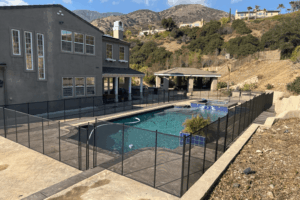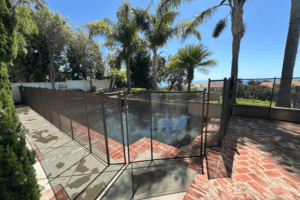
10 Questions to Ask Before Buying a Pool Safety Fence
Don’t buy a pool safety fence without asking these essential questions. This buyer’s guide helps you evaluate height, compliance, materials, installation, and more.

Understanding the different benefits of mesh vs. solid pool covers can help you make sure you’re creating a safer swimming pool that meets your needs for both peace of mind and convenience. Safety swimming pool covers do more than just keep leaves and debris from blowing into your pool. These ASTM-compliant pool safety barriers are designed to save lives by preventing unsupervised access to the water or accidental immersion. While both mesh and solid covers meet this high safety standard, each offers different benefits that may make one better for your pool than the other.
Accidental drownings cost thousands of lives annually and send tens of thousands of victims to hospitals and doctors’ offices seeking medical care for injuries. While this statistic is tragic enough, the most vulnerable members of society–our children–are the ones most at risk, with accidental drowning ranking as a leading cause of death for minors. In the majority of fatal drownings, a lack of adequate pool safety barriers is cited as a contributing cause. Whichever you choose when weighing mesh vs. solid pool covers, you’ll be taking the first step toward ensuring your pool doesn’t become a part of these troubling statistics.
Unlike standard swimming pool covers that are only meant to keep leaves and trash out of your pool, safety covers are anchored around the pool edge and made from a tear-resistant fabric. They can support the weight of a fully grown adult, making them perfect for not only protecting children but also inebriated party guests, those with medical conditions, or the elderly from accidental water entry that would otherwise see them falling into the pool. When it’s time for a swim, your cover can be removed in a matter of minutes and reinstalls almost as fast when you need to close the pool down for safety.

When considering mesh vs. solid pool covers, the only physical difference is that one fabric is solid while the other is a tight mesh with minuscule gaps in the material. Both are made of similar tear, UV, and chemical-resistant materials, and each one uses strong straps to attach to anchor points around your swimming pool’s deck. Because of the physical difference in the fabrics, however, mesh pool covers allow water to pass through to the pool as well as more UV-light and very fine particulate. Let’s take a look at the practical benefits of mesh vs. solid pool covers and what they mean for you.
Mesh pool covers act as a filter, blocking out large debris and preventing unsupervised pool access while allowing water and some ultra-small particulates, like dust or dirt, to pass through. They’re lightweight and easy to use, and debris removal is relatively easy. Simply collect larger pieces, like fallen branches, and sweep up leaves or trash. They also allow more sun to pass through, heating the water for a more comfortable swimming temperature earlier and later in the swimming season without needing a powered heater.
While cost-effective as an initial purchase, mesh vs. solid pool covers can contribute to higher ongoing expenses. By allowing small particulates to pass through, as well as both water and evaporated water vapor, you can find yourself needing more frequent and heavier chemical use for sanitation and conditioning while also needing to top-up your pool more often. These swimming pool covers also allow more UV radiation to reach the water’s surface, inhibiting the effectiveness of your pool chemicals. Mesh pool covers work best when you have the time and money to make more frequent cleaning and sanitation part of your pool ownership routine.
Solid pool covers are designed to keep out UV rays, water, and even the smallest debris. This can save you money on water conditioning and on your water bill, as evaporated water vapor is kept near the surface of the water as an insulating layer that can condense and fall back into the pool as temps drop. This also makes them a popular choice for colder winters, where the insulating layer of air helps prevent frost damage when the pool is properly winterized.
While still user-friendly, solid vs. mesh pool covers are heavier and often require more anchoring points due to the added potential weight from water trapped on the cover’s surface. You’ll need to either drain the pool cover or pump it to avoid standing water causing damage due to the prolonged weight load, and unmanaged water can also make these pool safety barriers more prone to failure due to excessive weight when called on to save a 200-pound human while already holding hundreds of pounds of water. Solid pool covers are best for dry, hot climates where evaporation is a constant threat or when you want to minimize your maintenance workload.
If you’re still up in the air over whether a mesh vs. a solid pool cover is right for your pool, your local independent All-Safe Pool installer can help. Our network of pool safety professionals live in the communities they serve and have the knowledge, tools, and experience to help you make an informed decision. It all starts with a phone call to set up an appointment for a free quote.
They’ll schedule a time to visit your pool area, take measurements, and talk to you about your pool safety needs and swimming lifestyle. Then, they’ll provide a personalized estimate on your pool safety barrier options and give you their best recommendation. Get started on creating a safer pool area for your friends, family, and pets. Get your free quote on All-Safe swimming pool covers today.

Don’t buy a pool safety fence without asking these essential questions. This buyer’s guide helps you evaluate height, compliance, materials, installation, and more.

Understand how local pool fence codes work and what to check before installation. This beginner’s guide simplifies requirements so your safety barrier complies and protects effectively.

Learn the truth behind common pool safety myths and make better decisions to protect your family with fact‑based guidance on fences, barriers, and maintenance.
Enter your zip code to locate an independent installer in your area
Enter your zip code to locate an independent installer in your area

Due to the many variations in monitors, phones, and browsers, color samples and product examples may appear different on different screens. Computers and mobile devices are not all calibrated equally and color reproduction on the Internet is not precise. The same is true for printed items such as brochures and other sales literature.
In addition, the colors of our products photograph differently under different lighting conditions. For example, photos taken in full sunlight will vary from photos taken on a cloudy or overcast day. Similarly, shadows from nearby objects can affect the color and transparency of our products. If a precise color or specific shade is important, please inspect the actual color of your product prior to installation.
Many of our products’ materials are not available through typical stores and vendors and therefore must be custom manufactured specifically for our use. In order to control costs and provide you with the best value possible, our raw materials are produced in large batches and can often take several months to receive. The colors of our materials can, and often do, vary slightly from batch to batch. Although we make every effort to minimize color variations, we cannot be responsible for these differences when they occur. If a precise color or specific shade is important, please inspect the actual color of your product prior to installation.
For example, we use the name “putty” to describe some of our products. Your idea of the color “putty” may be different than someone else’s idea of “putty”. In addition, products may have the same color name but may not be the exact same color. For example, we have different shades of “black”. Please do not order using color names as your only guide. If a precise color or specific shade is important, please inspect the actual color of your product prior to installation.
If it is important that your product be an exact color or shade, it is highly recommended that you inspect the actual product prior to its installation and address any concerns with your local independent installer. Most independent installers do not offer refunds or accept returns due to color variations.